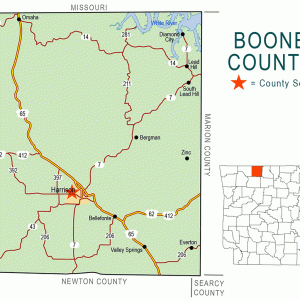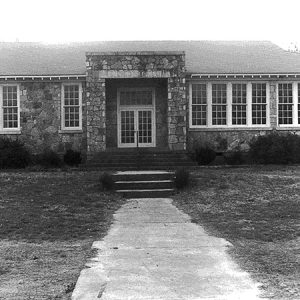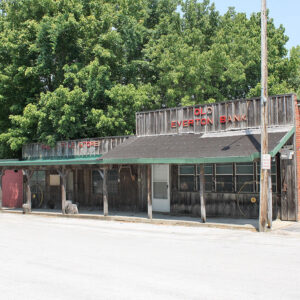calsfoundation@cals.org
Everton (Boone County)
| Latitude and Longitude: | 36°09’19″N 092°54’25″W |
| Elevation: | 860 feet |
| Area: | 0.47 square miles (2020 Census) |
| Population: | 104 (2020 Census) |
| Incorporation Date: | April 12, 1913 |
Historical Population as per the U.S. Census:
|
1810 |
1820 |
1830 |
1840 |
1850 |
1860 |
1870 |
1880 |
1890 |
1900 |
|
– |
– |
– |
– |
– |
– |
– |
– |
– |
– |
|
1910 |
1920 |
1930 |
1940 |
1950 |
1960 |
1970 |
1980 |
1990 |
2000 |
|
– |
– |
180 |
190 |
198 |
118 |
124 |
134 |
150 |
170 |
|
2010 |
2020 |
|
|
|
|
|
|
|
|
|
133 |
104 |
|
|
|
|
|
|
|
|
Everton is a town in southeastern Boone County on State Highway 206. The town began as a stop on the Missouri and North Arkansas Railroad (M&NA) and quickly became an agricultural center for the region.
Osage from the north came into the region to hunt and to fish, but what would become Boone County remained sparsely populated until after Arkansas became a state. Some settlers made their homes along Clear Creek in the area that would become Everton. Among those who purchased land deeds were William Ryals in 1849 and James Bradshaw, Seborn Jones, and John Reeves in 1854. No significant events took place in the immediate vicinity during the Civil War, although five deceased Confederate soldiers were interred in the Newton Cemetery north of the settlement when transportation of the bodies became burdensome.
The M&NA was built through Boone County to Harrison (Boone County) in 1901. Everton is one of thirty-three new communities that came to life due to the railroad. James Logan Rush of Jasper (Newton County) purchased seventy-five acres of land and had the town platted in 1902. The railroad depot and post office, both established in 1902, were probably named for a railroad executive or employee. A schoolhouse was built in 1903. By 1906, Everton had a Methodist church, a general store, a sawmill, and a cotton gin. Rush opened a drugstore, and other investors opened a hotel, a furniture-hardware-and-grocery store, and a general store. Locally grown fruits, vegetables, cotton, and eggs were shipped from the depot, as well as railroad ties and lumber. There were also some lead and zinc mines in the area, operated by the Everton Mining and Development Company.
The town was incorporated in 1913. By 1915, the town had a bank, four or five general stores, a large hardware store, a drugstore, two hotels, and two flour mills. The schoolhouse burned during that decade and was replaced by a brick structure. Four newspapers were attempted in Everton, but the most successful, the Everton Star, lasted only two years. A corn-cob pipe factory opened in Everton in 1923, and at least one cannery operated in the town.
The Depression crippled the agricultural community of Everton. The bank closed on September 1, 1931. Many residents of the town and the nearby farms traveled west looking for jobs. The school was razed in 1938 by the Works Progress Administration (WPA), which replaced it with a new building, using much of the original material. The new school building was dedicated in April 1939. The corn-cob pipe factory continued to operate during the Depression, turning out 6,000 pipes a day by the late 1930s. The factory paid farmers thirty cents per pound of shelled cobs, while the same farmers were receiving twenty-five cents a pound for the corn itself. A plant in Everton processed silica mined near Everton until 1946.
Everton was devastated by two fires, the first in December 1942 and the second in April 1944. The earlier fire originated in the Pete Dahlman Grocery Store and destroyed a garage, a barbershop, a produce-and-feed store, and two empty buildings. The later fire began in a room attached to the post office and destroyed a grocery store, a restaurant, a general store, a feed store, and a barber shop, as well as some of the mail in the post office. Only two grocery stores remained in the downtown area. The corn-cob pipe factory closed in 1942, unable to hire enough workers due to World War II.
In 1948, the school district of Everton was consolidated with Bellefonte (Boone County) and Valley Springs (Boone County), with the new district using the buildings in Valley Springs. The school building in Everton was sold in 1949 to the Methodist congregation for $2,500. On September 10, 1992, it was added to the National Register of Historic Places. The Bruno-Pyatt School District was established northeast of Everton in 1974. It remains the largest employer of Everton’s residents.
In 1976, State Highway 206, also known as the Everton Road, was completed through Everton. Everton has several businesses in the twenty-first century. Among the local churches are the Methodist church, a Baptist church, and a Full Gospel church. Everton also has a community center, built in 2005 and designed to resemble a railroad depot. Everton made news after Florida businessman Leon Trammell donated the cost for building a new fire station for the town provided that it be named the Donald J. Trump Fire Station. The station was built in 2023.
For additional information:
Boone County Historical and Railroad Society. History of Boone County. Paducah, KY: Turner Publishing Co., 1998.
Bowden, Bill. “Everton Given New Fire Station; Trump Name Mandatory.” Arkansas Democrat-Gazette, April 7, 2024, pp. 1B, 3B. Online at https://www.arkansasonline.com/news/2024/apr/07/businessman-gives-boone-county-town-a-new-fire/ (accessed April 8, 2024).
Handley, Lawrence R. “Settlement across Northern Arkansas as Influenced by the Missouri & North Arkansas Railroad.” Arkansas Historical Quarterly 33 (Winter 1974): 273–292.
Migliore, Roscoe Channing. “The Arkansas Cob Pipe Factory.” Ozarks Mountaineer 22 (March 1974): 22–23.
Steven Teske
Butler Center for Arkansas Studies
 Boone County Map
Boone County Map  Everton School
Everton School  Everton Street Scene
Everton Street Scene 




Comments
No comments on this entry yet.